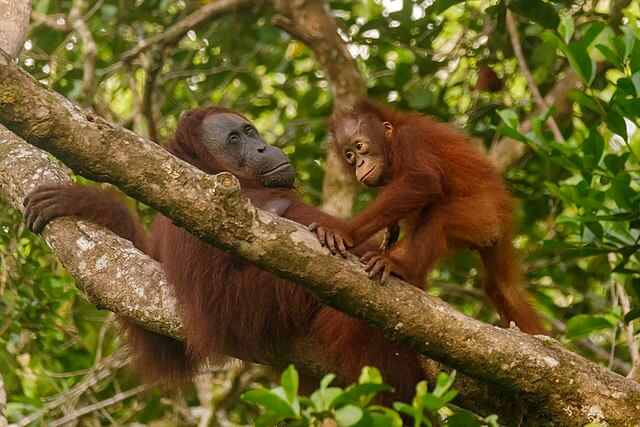
In 2011, German conservationist Robert Risch embarked on a hike along a river that skirts the northern fringes of the Tabin wildlife reserve, a sanctuary for pygmy elephants, orangutans, and the endangered Bornean banteng, a wild cattle species.
To his dismay, he encountered palm oil plantations and electric fences rather than the anticipated wilderness. This land parcel, situated within Malaysia’s Sabah state on Borneo island, sits between the Tabin and Kulamba wildlife reserves, forming a vital corridor for wildlife movement.
“I found elephant tracks coming from Tabin following the river to the north until they reached the electric fence. Then the tracks turned around back to Tabin,” says Risch. “No choice.”
Responding to this challenge, Risch established the Rhino and Forest Fund (RFF) in 2009 with a vision to reunite Tabin and Kulamba, ultimately creating a sprawling 200,000-hectare wilderness. The Kulamba reserve is adjacent to the Lower Kinabatangan-Segama wetlands, an internationally significant Ramsar site.
In 2019, RFF acquired 65 hectares of land, presenting it to the Sabah forestry department for conservation. This seemingly modest acquisition marked the first terrestrial link between the reserves in decades, yielding an 800-meter-wide corridor, spacious enough to accommodate elephants.
Upon dismantling fences, elephants promptly reclaimed the passage, reuniting previously isolated populations. This region harbours a substantial number of Bornean pygmy elephants, a distinct evolutionary branch that has remained detached from mainland elephant groups for 300,000 years.
In addition to facilitating wildlife movement, RFF undertook land restoration efforts, encompassing native tree and grass planting, invasive species removal, and the establishment of a small lake.
“[In 2022], after working in the area for a full decade, we saw for the first time orangutan, proboscis monkey, red leaf monkey and Storm’s stork [considered to be the rarest of all storks, with probably fewer than 500 left worldwide] in our restoration site,” Risch says.
The project aligns with Sabah’s conservation objectives, which emphasise reconnecting isolated populations of charismatic species such as the critically endangered Bornean orangutans.
“The major threat for these species in this landscape is not deforestation or poaching, but fragmentation,” says Marc Ancrenaz, head of the local community-based conservation organisation Hutan, and an expert on orangutans.
Benoît Goossens, director of the Danau Girang field centre—a collaborative venture between the Sabah wildlife department and Cardiff University—advocates “connectivity” restoration as a central tenet of the state’s conservation strategy. Approximately 1,700 critically endangered Bornean orangutans are scattered across the region, many of them disconnected from one another.
“[Our] work in Kinabatangan and other areas shows that creating forest corridors between isolated patches of forest occupied by orangutans contributes to sustaining viable orangutan meta-populations [separated groups of one species] over large landscapes,” he says.
RFF’s future endeavours include acquiring additional plantation land to widen the wildlife corridor. The organisation is striving to secure 540 more hectares at an estimated cost of $5 million. However, land prices here are steep due to the high potential for lucrative palm oil cultivation—a dominant industry in the area.
“The special thing with oil palm is it’s highly productive,” says Risch. “So buying oil palm land for conservation is not a low hanging fruit to pick.”
Malaysia and Indonesia’s palm oil industry boom over recent decades has led to extensive deforestation, wildlife loss, and human-wildlife conflicts.
Despite this, Sabah has committed to safeguarding 30% of its undeveloped land area by 2025. Engaging with the palm oil industry to designate conservation zones, particularly along riverbanks, is seen as crucial by experts like Ancrenaz. Strategies like agroforestry, which simultaneously benefit biodiversity and local communities, also hold significance in the battle to preserve Sabah’s natural heritage.
“Although creating protected areas must remain the cornerstone for conservation, this approach alone is not enough for those wide-ranging species,” says Ancrenaz.
“We also need to manage better the non-protected landscapes occupied and used by people and where the animals are found.”
——————————————————————————
At Natural World Fund, we are passionate about stopping the decline in our wildlife.
The decline in our wildlife is shocking and frightening. Without much more support, many of the animals we know and love will continue in their decline towards extinction.
When you help to restore a patch of degraded land through rewilding to forests, meadows, or wetlands, you have a massive impact on the biodiversity at a local level. You give animals a home and food that they otherwise would not have had, and it has a positive snowball effect on the food chain.
We are convinced that this is much better for the UK than growing lots of fast-growing coniferous trees, solely to remove carbon, that don’t actually help our animals to thrive.
This is why we stand for restoring nature in the UK through responsible rewilding. For us, it is the right thing to do. Let’s do what’s right for nature!
Donate today at https://naturalworldfund.com/ and join in the solution!

